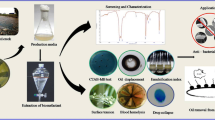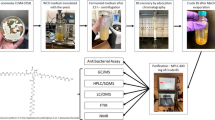Abstract
A newly discovered bacterium, Lysinibacillus chungkukjangi, was isolated from the sludge of rice bran oil processing. When the bacterium was grown on rice bran, it produced biosurfactant which reduced the surface tension of the media to 27.9 from 72 mN/m. The biosurfactant was recovered by a solvent extraction method and characterized with the help of various structure elucidation techniques viz. FTIR, 1H- and 13C-NMR spectroscopy and LC–MS analysis. The combined results of FTIR and NMR revealed the presence of carbonyl, olefinic and aliphatic groups, with the typical spectra of lipids. Moreover, LC–MS analysis also supported the same information. The biosurfactant was also studied for its anti-oxidant and microbial enhanced oil recovery (MEOR) potential. The anti-oxidant activity was observed by the DPPH free radical scavenging method using ascorbic acid as the standard. The IC50 (the half maximal inhibitory concentration) was calculated and for standard, it was 0.056 mg/mL and for the biosurfactant it turned out to be 1.3 mg/mL which shows its good anti-oxidant potential. The sandpack test was performed to check its MEOR potential and kerosene was recovered up to 90 %, which shows its excellent applicability in the MEOR processes.









Similar content being viewed by others
References
Vater J, Kablitz B, Wilde C, Franke P, Mehta N, Cameotra SS (2002) Matrix-assisted laser desorption ionization-time of flight mass spectrometry of lipopeptide biosurfactants in whole cells and culture filtrates of Bacillus subtilis C-1 isolated from petroleum sludge. Appl Environ Microbiol 68:6210–6219
Biria D, Maghsoudi E, Roostaazad R, Dadafarin H, Lotfi AS, Amoozegar MA (2010) Purification and characterization of a novel biosurfactant produced by Bacillus licheniformis MS3. World J Microbiol Biotechnol 26:871–878
Fracchi L, Cavallo M, Martinotti MG, Banat IM (2012) Biosurfactants and bioemulsifiers biomedical and related applications-present status and future potentials. In: Dhanjoo N, Ghista (eds) Biomedical Science, Engineering and Technology. In Tech, pp 325–370
Bhardwaj G, Cameotra SS, Chopra HK (2013) Biosurfactants from fungi: a review. J Petro Environ Biotechnol 4:160
Bhardwaj G, Cameotra SS, Chopra HK (2013) Utilization of oleo-chemical industry by-products for biosurfactant production. AMB Express 3:68
Morikawa M, Daido H, Takao T, Murata S, Shimonoshi Y, Imanaka T (1993) A new lipopeptide biosurfactant produced by Arthrobacter sp. Strain MIS38. J Bacteriol 175:6459–6466
Yakimov MM, Timmis KN, Wray V, Fredrickson HL (1995) Characterization of a new lipopeptide surfactant produced by thermotolerant and halotolerant subsurface Bacillus licheniformis BAS50. Appl Environ Biotechnol 61:1706–1713
Kim HS, Yoon BD, Lee CH, Suh HH, Oh HM, Katsuragi T, Tani Y (1997) Production and properties of lipopeptide biosurfactant from Bacillus subtilis C9. J Fermen Bioeng 84:41–46
Fox SL, Bala GA (2000) Production of surfactant from Bacillus subtilis ATCC 21332 using potato substrates. Bioresour Technol 75:235–240
Anyanwu CU, Obi SKC, Okolo BN (2011) Lipopeptide biosurfactant production by Serratia marcescens NSK-1 strain isolated from petroleum contaminated soil. J Appl Sci Res 7:79–87
Mandal SM, Sharma S, Pinnaka AK, Kumari A, Korpole S (2013) Isolation and characterization of diverse antimicrobial lipopeptides produced by Citrobacter and Enterobacter. BMC Microbiol 13:152
Katz E, Demain AL (1977) The peptide antibiotics of Bacillus: chemistry, biogenesis and possible functions. Bacteriol Rev 41:449–474
Baindara P, Mandal SM, Chawla N, Singh PK, Pinnaka AK (2013) Characterization of two antimicrobial peptides produced by a halotolerant Bacillus subtilis strain SK.DU.4 isolated from a rhizosphere soil sample. AMB Express 3:2
Bhardwaj G, Cameotra SS, Chopra HK (2015) Utilization of oil industry residues for the production of rhamnolipids by Pseudomonas indica. J Surfact Deterg 18:887–893
Yalçin E, Çavuşoglu K (2010) Structural analysis and antioxidant activity of a biosurfactant obtained from Bacillus subtilis RW-I. Turk J Biochem 35:243–247
Pruthi V, Cameotra SS (1997) Production and properties of a biosurfactant synthesized by Arthrobacter protophormiae- an antarctic strain. World J Microbiol Biotechnol 13:137–139
Aparna A, Srinikethan G, Smitha H (2012) Production and characterization of biosurfactant produced by a novel Pseudomonas sp. 2B. Colloids Surf B 95:23–29
Rufino RD, Luna JM, Takaki GMC, Sarubbo LA (2014) Characterization and properties of the biosurfactant produced by Candida lipolytica UCP 0988. Electron J Biotechnol 17:34–38
Govindammal M (2014) Effect of Carbon and Nitrogen Sources on the Production of Biosurfactant by Pseudomonas fluorescens isolated from Mangrove Ecosystem. Int J Pharm Biol Arch 5:108–115
Bhardwaj G, Cameotra SS, Chopra HK (2015) Isolation and purification of a new enamide biosurfactant from Fusarium proliferatum using rice-bran. RSC Adv 5:54783–54792
Silva EJ, Silva NMPR, Rufino RD, Luna JM, Silva RO, Sarubbo LA (2014) Characterization of a biosurfactant produced by Pseudomonas cepacia CCT6659 in the presence of industrial wastes and its application in the biodegradation of hydrophobic compounds in soil. Colloids Surf B 117:36–41
Hazra C, Kundu D, Chaudhari A (2015) Lipopeptide biosurfactant from Bacillus clausii BS02 using sunflower oil soapstock: evaluation of high throughput screening methods, production, purification, characterization and its insecticidal activity. RSC Adv 5:2974–2982
Williams K (2009) Biosurfactants for cosmetic applications: overcoming production challenges. MMG 445 Basic Biotechnol eJournal 5:78–83
Kuiper I, Lagendijk EL, Pickford R, Derrick JP, Lamers GEM, Thomas-Oates JE, Lugtenberg BJJ, Bloemberg GV (2004) Characterization of two Pseudomonas putida lipopeptide biosurfactants, putisolvin I and II, which inhibit biofilm formation and break down existing biofilms. Mol Microbiol 51:97–113
Morikawa M, Hirata Y, Imanaka T (2000) A study on the structure-function relationship of lipopeptide biosurfactants. Biochim Biophys Acta Mol Cell Biol Lipids 1488:211–218
Pecci Y, Rivardo F, Martinotti MG, Allegrone G (2010) LC/ESI-MS/MS characterisation of lipopeptide biosurfactants produced by the Bacillus licheniformis V9T14 strain. J Mass Spectrom 45:772–778
Hathout Y, Ho YP, Ryzhov V, Demirev P, Fenselau C (2000) Kurstakins: a new class of lipopeptides isolated from Bacillus thuringiensis. J Nat Prod 63:1492–1496
Kiran GS, Hema TA, Gandhimathi R, Selvin J, Thomas TA, Ravji TR, Natarajaseenivasan K (2009) Optimization and production of a biosurfactant from the sponge-associated marine fungus Aspergillus ustus MSF3. Colloids Surf B 73:250–256
Acknowledgments
The authors are highly indebted to SLIET, Longowal and IMTECH, Chandigarh for providing the necessary facilities to carry out this research.
Author information
Authors and Affiliations
Corresponding author
About this article
Cite this article
Bhardwaj, G., Cameotra, S.S. & Chopra, H.K. Biosurfactant from Lysinibacillus chungkukjangi from Rice Bran Oil Sludge and Potential Applications. J Surfact Deterg 19, 957–965 (2016). https://doi.org/10.1007/s11743-016-1857-0
Received:
Accepted:
Published:
Issue Date:
DOI: https://doi.org/10.1007/s11743-016-1857-0




